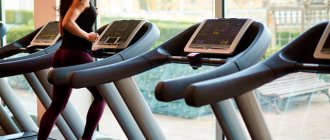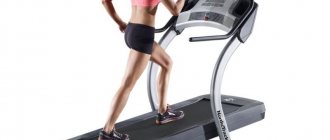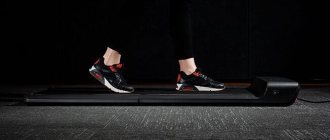Does running on a treadmill help you lose weight?
Before buying a treadmill for home, many people ask whether running on a treadmill helps you lose weight or whether it is only used for warming up and warming up your muscles before a workout. There is only one answer - yes! Running on a treadmill is an effective cardio that is aimed at burning excess fat, and with the correct running technique, at developing the endurance of the body as a whole. After all, running is an aerobic exercise, during which our entire circulatory system is saturated with oxygen. However, it is worth remembering that if you run on a treadmill 1-2 times a week, you will not achieve the desired effect. In order for the weight to go away, it is important to follow 2 rules:
- Treadmill training should be regular, ideally 4 times a week.
- The duration of the workout should be at least 30-40 minutes.
- It is important to follow a diet so that the number of calories burned on the treadmill is not lost in the number of snack calories afterward. Simply put, follow a proper diet.
In addition to losing weight, running on a treadmill has many benefits for various body systems. And first of all, it strengthens the cardiovascular system. While running, you train your heart muscle, which results in normalized blood pressure and improved well-being. Naturally, running also has a positive effect on the respiratory system, because during such cardio training we actively breathe, increasing the volume of the lungs and saturating all body systems with oxygen. And of course, during any physical activity, our body produces happiness hormones - endorphins, which cause a feeling of happiness, joy and satisfaction.
Choose a treadmill
Why does the canvas slip?
There may be several reasons for this.
Firstly, the running belt tension is incorrect. If it is too tight or not properly centered or adjusted, it will slip during training.
The second reason for braking is wear of the running belt. This is a completely logical phenomenon; all things wear out. But they deteriorate much faster if they were not cared for correctly or not cared for at all. Regular cleaning and lubrication of your running belt will help extend its life.
The third reason lies in the incorrect connection of the treadmill to the outlet. Braking, especially when switching to walking, indicates problems in the supply of nutrition. To correct this defect, review the instructions and make sure that the track is connected to the network correctly or call a technician.
Masters in Moscow
Masters in St. Petersburg
Other cities
Correct running and walking technique on a treadmill
First, a few simple but effective tips for those who want to learn how to run on a treadmill correctly:
- Don't forget to warm up before getting on the treadmill. Perform a simple set of exercises for 10 minutes. This can be swinging your head, arms, bending, squats. Be sure to stretch your ankle. The purpose of the warm-up is to warm up the muscles and joints so as not to get injured on the track.
- As we wrote earlier, run regularly for 30-40 minutes.
- During training, change running and walking modes: for example, 5 minutes of intense running, then 5 minutes of active walking (for example, uphill), then 5 minutes of easy running and finally 5 minutes of walking at an average pace.
- We recommend constantly monitoring your heart rate while running. This can be done using special cardio sensors, which are worn separately or using the built-in functionality of the treadmill (more expensive models). The optimal average heart rate (heart rate) while running on a treadmill is considered to be 120 beats per minute. However, this indicator may depend on many factors: weight, physical fitness and age. There is a simple formula for calculating the permissible load and heart rate during training: you need to subtract your age from 220. For example, for a 40-year-old person, the permissible heart rate when running is 220-40 = 180 heart rate.
- Never end your workout with intense running. It is important not to stop immediately after running, but to even out your breathing by walking for a few minutes.
- After running, do a simple cool-down; it will allow you to even out your heart rate, normalize your breathing and allow the release of lactic acid, which is sure to accumulate in the muscles during running and active walking.
At what speed does running begin?
It is considered that running begins at a speed of 10 km/h. This is the so-called jogging or jogging (slow running). But the difference between running and walking is not in speed, but in the difference in the load on the body.
While walking, one foot is firmly on the ground, and while running, there is a moment when both feet are in the air. This is the fundamental difference between walking and running.
Depending on a person's physical fitness, running can begin at different speeds. For example, professional athletes who walk reach a speed of 15 km/h; it is difficult for an ordinary person to even run at such a speed.
For the average treadmill user, the walking speed is 4 km/h, at 7 km/h you should already make an effort. Same with running. Depending on their training and body capabilities, people can start running at a speed of 7 km/h; advanced users switch to running at a higher speed of the belt.
How long to run on a treadmill to lose weight
As we said earlier, 10-minute runs on a treadmill will not give the desired results in losing weight. This is due to the fact that in the first 10 minutes of running, the body spends energy from the glucose and glycogen accumulated up to this point. You will simply burn the calories you ate at breakfast. Fat reserves begin to be used up only after 20-30 minutes of intense training. Conclusion - for running on a treadmill to burn the right calories, the duration of the workout should be 30-40 minutes.
How to use the machine
First of all, you need to figure out how to turn on the treadmill. As a rule, to do this you need to click on the “Start” or “Start” buttons. Before performing such actions, set the speed and inclination angle on the device. The safety key deserves special attention - one end of it is fixed on the console, and the other is attached to the runner’s belt. Thanks to this element, it is possible to prevent injuries. If a runner accidentally falls, the machine will immediately turn off.
Before setting any functions, you need to press the “Pause” or “Stop” button. After this, you can enter the required data and select “Start”. Changing parameters while driving is prohibited.
To understand exactly how to use a treadmill, you should keep in mind that it has adjustable speed and incline levels. On some devices, it is possible to enter certain digital values, while on others, settings are made by pressing buttons marked “plus” and “minus”.
To maximize the effectiveness of running on a treadmill for weight loss, you also need to study the additional functions that the devices are equipped with:
- Entering body weight - allows you to adjust your training plan.
- Fan - turns on if necessary.
- Holder for water container.
- Vibrating massager.
- Rollers allow you to move the machine with ease.
- Compensator for uneven floor coverings.
The device can also be equipped with a number of additional functions, for example, a TV tuner, Wi-Fi, touch or color display. All of them are optional and do not affect the effectiveness of training.
Treadmill console option with overview of key keys
Security Key
The functionality of the simulator may include rollers, a vibration massager, and a compensator for uneven floor coverings.
Some treadmill models can be equipped with a TV tuner, Wi-Fi, or a touch screen
How many calories are burned during exercise?
Let's talk about numbers, namely, how many calories are burned during various running and walking techniques on a treadmill.
- Walking on a flat plane with minimal elevation angles of the treadmill belt. In 60 minutes, women burn an average of 250 calories, men - 300-330.
- Walking uphill. In an hour, a woman will lose 700 kcal, a man - 920. The numbers are pleasant, but remember that without good physical shape, an entire hour of such exercise is more likely to cause harm than good. Combine uphill walking with regular walking.
- Run at a medium pace. In 60 minutes, a woman will burn 550 calories, a man - 850 kcal.
- Intense running. In an hour, oddly enough, the calories will correspond to running at an average pace. The conclusion is simple - it makes no sense to strain yourself and always try to run at a high pace; you will overload the body and all its systems.
In total, in order to burn 500 calories in 1 workout of 60 minutes, it is enough to walk for 20 minutes at a normal pace, then jog for 5-7 minutes at a high heart rate, then walk uphill for 10 minutes and run for another 5-7 minutes at an average pace at a low heart rate. . This approach (with a warm-up at the beginning and a cool-down at the end) will allow you to burn fat reserves as efficiently as possible, without overloading all body systems.
Food for thought
A speed of 6 km per hour is a fast walk or a slow jog for many athletes. To improve fitness and speed, runners must increase the intensity and duration of their workouts. This can be achieved by increasing your running speed and distance.
If you start at 4 mph, aim to increase your speed so you can work outside your comfort zone for a certain period of time, such as a minute or two during a run. Track your progress and increase your speed and distance as your fitness improves.
How to exercise correctly
Running helps develop endurance, has a positive effect on the cardiovascular and immune systems, improves skin tone and metabolism. To make physical activity on a treadmill more effective, it is worth considering:
- proper nutrition, drinking regime;
- regularity of classes;
- choosing suitable clothes and shoes;
- correct exercise technique;
- heart rate control.
Warm-up
Before exercising on a treadmill, you need to prepare your muscles and joints for further stress. Warm-up includes joint exercises, basic exercises to warm up muscles and dynamic stretching.
A standard warm-up program might look like this:
- Head rotation.
- Rotations of shoulders, forearms.
- Tilts of the body to the right-left-forward-back.
- Swing your arms with a body turn.
- Hip rotation.
- Knee rotation.
- Running in place with shin overlapping.
- Running in place with hip lift.
- Lunges forward, to the sides.
- Rotation of the feet.
It is important to properly stretch your body and joints, since this type of physical activity involves almost all muscle groups.
Shoes
When exercising on a treadmill, it is important to choose the right shoes. Sneakers for running on uneven roads or slippery surfaces have an aggressive tread and a thick sole. Such models are not suitable for flat treadmill surfaces. It is better to choose lightweight, breathable road running shoes designed for running on asphalt or special surfaces.
Pay attention to the cost of shoes. For beginners, there is no point in buying expensive professional sneakers, since they need to be updated regularly. With constant training, any shoes lose their shock-absorbing properties and will not be as comfortable to exercise in. If an old pair looks good, it can be used for walking outside, but it is no longer suitable for running. You should buy expensive sneakers if you are taking part in a competition or an important race.
Water
During active physical activity, a person sweats. This means that the body is using up its fluid reserves and needs to be replenished. However, you should not drink a lot of water during the race. It is optimal to take a few small sips when you feel thirsty .
Often, when wanting to drink, athletes drink much more water than they should. This can cause discomfort while running. Hyponatremia may also occur. This is a condition where the sodium in the blood is diluted by a large volume of fluid. In this case, the person experiences weakness, dizziness, nausea, and headaches.
It is also important to stay hydrated before and after running on the treadmill. It is better to drink the last glass of water 1-2 hours before the start of your workout. Within two hours after finishing the cross-country, drink 2-3 glasses to replenish lost fluids.
Pulse
Many new runners are interested in how to effectively run on a treadmill. The effectiveness of the exercise directly depends on the person’s pulse. Let's look at several pulse zones to understand their features:
- 55-65% of the maximum is a zone suitable for improving the functioning of the respiratory and cardiovascular systems;
- 65-75% of the maximum – heart rate suitable for burning calories;
- 75-85% of the maximum is the zone in which endurance development occurs.
A heart rate monitor is used to measure your pulse and select the appropriate program. Using this device, you can monitor your heart rate throughout the activity to stay in the desired heart rate zone. You can also move from one zone to another, gradually increasing or alternating loads. A professional trainer will help beginners create a suitable running training program depending on the individual's needs.
Intensity
The final result of exercise also depends on the intensity of physical activity. For beginner athletes, it is better to choose low-intensity training, increasing the load over time. You can start with a fast step, gradually moving to light and more intense running.
For weight loss, interval schemes are suitable, during which the load alternates. This exercise consists of several approaches of walking and intense jogging, replacing each other.
For experienced runners, the most intense races are suitable. This load can be achieved by running at speed with weights or on an inclined track. However, this option is only suitable for professionals who have a sufficient level of training.
Hitch
For joggers, it is important to understand not only how to properly train on a treadmill, but also how to complete the session. After finishing a running workout, you should not stop at once or immediately go to rest. Low heart rate exercises are used to gradually restore the body.
A proper cool-down is of great importance for the overall result. It helps restore breathing, gradually reduce heart rate, and restore muscle tissue.
During your cool down, you can do the following exercises:
- jogging;
- tilts to the ground;
- walking on toes and heels;
- stretching;
- breathing exercises.
Neglecting a cool-down can lead to breathing problems, the development of diseases of the cardiovascular system, and the accumulation of lactic acid in the muscles of the body.
Benefits and harms
- The entire muscular skeleton is strengthened, because such an exercise uses the muscles of almost the entire body;
- The device makes it possible to regulate the amount of load, so people with different levels of training can exercise on it;
- Girls will certainly appreciate the benefits of a figure simulator, because running training for weight loss allows you to burn 600-800 calories in an hour;
- What do you think running on a treadmill does for the body? That's right - this is an excellent workout for the lungs, heart and vascular system. The athlete’s blood pressure normalizes, the blood is saturated with oxygen, and the lungs increase in volume. As a result, your well-being improves and your endurance increases;
- Metabolism improves, the skin becomes more elastic, the intensity of cellulite decreases;
- Also, a treadmill helps relieve accumulated irritation, get rid of stress, and distract from obsessive thoughts.
A treadmill cannot cause any noticeable harm, of course, if you run correctly, following the technique and setting yourself an adequate load. Among the disadvantages of the device, we note the following:
- Running in the park will always be more correct and healthier, because here you breathe fresh air. Not a single gym, even with the highest quality ventilation, can provide you with such conditions;
- Although the running technique on a treadmill does not differ from the technique in natural conditions, the machine still creates an artificial environment. If you run outside, on sand, gravel, asphalt or even a running surface, your joints and muscles receive a more “native” load.
- To be able to run on a treadmill, you will have to purchase a gym membership, which often takes a significant toll on your pocket. Also, you will have to adapt to the schedule of the fitness center.
- To run correctly, you will have to understand the machine settings and ask more experienced athletes for help. You can run outside on your own, at any time of the day or night.
- Athletes must observe safety precautions, since the treadmill holds the record for the number of accidents in the gym. Here is a brief set of rules for working with the device: you cannot hold on to the handrails (if the device is equipped with them), look at your feet on the canvas, jump at high speed, and exercise in shoes not intended for running.
- Another disadvantage, which would be wrong not to mention, is monotony and boredom. Imagine, you will have to spend a whole hour in one place, performing monotonous actions. We advise you to stock up on a good playlist.
Answering the question whether running on a treadmill is harmful, we will say “no,” but we emphasize that you should not have any contraindications:
- If you are obese, it is correct to start with walking on a treadmill, only then switch to running;
- You should not run with high blood pressure;
- Diseases of the musculoskeletal system;
- Inflammatory processes accompanied by pain, increased body temperature;
- Diseases of the heart, respiratory system;
- After a heart attack or stroke;
- For glaucoma;
- After abdominal operations;
- For injuries;
- During pregnancy (walking is recommended).
So, we have listed the pros and cons of running on a treadmill, now let's talk about technique.
Contraindications
For a healthy person, jogging is a storehouse of benefits, but if you have any diseases, it is better to think carefully: is it worth starting exercises?
So, running is not recommended in the following cases:
- Serious disorders of the heart: previous heart attack, stroke, angina pectoris and other pathologies.
- Diseases of the respiratory system: bronchial asthma, pulmonary insufficiency.
- Problems with joints and spine: arthritis, arthrosis, hernias, osteochondrosis in an acute stage.
- Visual impairment: severe and progressive myopia, glaucoma.
Please note that you should not run during a cold or after an injury or surgery. Girls should avoid intense and long runs on menstruation days.
Exercising correctly: useful training tips
Before you start regular running, you need to prepare - draw up a rough training plan, decide on their frequency, and also purchase the equipment that suits you.
Equipment
The first thing you need to know before classes is that you absolutely cannot run on a treadmill without shoes. Therefore, you will have to buy sneakers. Choose special models for running - their soles should be of normal thickness, moderately flexible, and the material should be soft for the foot and wick away moisture, because while running, the feet can sweat a lot.
As for clothing, it should be light and not restrict movement. If you work out in the gym and feel uncomfortable in clothes that are soaked with sweat, choose dark colors—the moisture is less visible on them.
Advanced runners can use dumbbells and weights to further challenge their muscles.
Choosing a time for classes
Despite the fact that even among athletes there are two camps: for evening jogging and for morning exercise, you must determine the time individually in accordance with your biorhythms and lifestyle.
If you decide to run in the morning, then you should start the activity about a quarter of an hour after waking up. If in the evening, then a few hours before bedtime.
How often should you run?
The regularity of training is determined depending on the body's endurance and level of physical fitness. For beginners and those who want to lose weight, 3-4 classes per week will be enough.
If you have other workouts, then you need to first think about how to combine them with running so that the load is not unnecessary and does not cause harm.
Running duration
At first, classes should not last more than 20 minutes, and when the body gets used to it, the time can be increased to 30-40 minutes. No more - otherwise you risk overloading your spine and joints.
Why does the treadmill stop while I'm running?
The treadmill is a complex exercise machine. If one of its components malfunctions, it may stop while running, which can lead to injury.
Let's consider the main reasons for this phenomenon:
- Excessive fabric tension. To check the tension of the canvas, try lifting its edge up. If it rises less than 1-2 cm, then it needs to be loosened.
- Worn motor drive brushes. If the brushes are weakly pressed against the contacts, they should be replaced;
- Overheating of elements. In this case, the temperature sensor is triggered and operation stops. Try cleaning the engine compartment of dust - most often overheating is caused by contamination.
- Dead battery. If there is a significant loss of charge in the battery or accumulator, with the help of which the parameters selected by the runner are regulated, the mechanical treadmill may stop spontaneously.
To prevent device failure, check its maintenance regularly, lubricate it at least once a year and center the blade as necessary.
While running, observe the operation of the simulator - if any extraneous noise appears: creaking, humming, buzzing, you should immediately contact a maintenance specialist.
Where to start training on the track?
If a person has never run or has not run for a long time, it is recommended to start training with walking on a treadmill.
Fast walking can be either an additional training option or a main one.
Walking on a machine will prepare the main muscle groups for further, more complex types of running. At first, walking can replace full-fledged running training.
The benefits of walking are tangible. This is a gentle type of physical activity, therefore it is indicated for people suffering from heart disease, in the postoperative period, and also for those with varying degrees of obesity.
After some time, you can move on to other, more intense types of training.
If you want to practice speed in your next workout
It's no secret that running fast takes practice. If you're not using inclines in your workout, it's more important to focus on speed. Recent studies have shown that running at an increasing level has a better effect on speed than running at an incline.
The frequency and intensity of speed intervals depends greatly on individual characteristics, but in general, it is better to choose a short, but very fast, or a long, but not much faster, interval. For example, if your normal pace is 6 mph, try 7.5 mph for 20 to 30 seconds and then return to your normal speed for two minutes. Or you can speed up to 6.5 mph for two minutes, then return to your normal speed for two minutes.
Best time to practice
Of course, each person chooses the time based on personal capabilities, but the best time is called the morning hours after waking up. Training will force the body to wake up, the person will receive a boost of energy, and will burn unnecessary energy that the body did not use up during the night.
But you shouldn’t get hung up on this: if you can’t run in the morning, choose the evening hours.
Just remember that going to bed immediately after training is not recommended.
How to turn the trainer on and off?
This article will only cover electric treadmills, as you only need to start walking to enable mechanical options. The use of sensors and devices on mechanical tracks is similar to electrical ones.
Well, if you don’t want to waste time reading the material at all and want to figure it out yourself, read only the minimum basic information :
- stand on the side runners and grab the handles;
- press Quick Start (usually a large colored button);
- you start running;
- adjust the speed to the desired level using two large switches;
- stop the movement with the Quick Start button or the big red button.
If you want to use your treadmill as little as possible, you don't need to know anything else. Well, if you plan on regular training, read on.
By the way, on many tracks you should simply press the Start button twice.
After this, by default, 2-3 seconds after pressing, movement begins at a minimum speed. Carefully! Never try to stand up or jump onto a fast-moving walkway.
First stand on the side runners, and get on the track only after first reducing your speed. For more advanced use, you will need to know how to create programs (or select programs) before starting a workout, how to set the incline, and use other functions.
About the treadmill
Modern cardio equipment amazes with its variety and technology. But the basis of classes on them is always built on ordinary physics, taking into account the laws of the physiology of the body. Here we always deal with concepts such as work, intensity, power, heart rate, duration, etc. That is, with specifically measurable concepts.
A treadmill in English is called a treadmill, which literally means “device for walking.” We call it a treadmill. Actually, this is a walking machine that you can run on.
The main components of the treadmill are the control panel and the running belt along which you need to walk.
Treadmill
The remote control may look very complicated, but in reality its main functions are:
- Change the driving speed using two keys (increase and decrease).
- Changing the angle of the running tape using two keys (up and down).
- Start and stop buttons.
The remote control panel may contain a lot of other buttons (fan, activation of special built-in programs, load monitor, information about the distance traveled, heart rate, inclination angle, etc.). And, frankly, no serious coach uses most of these options.
Treadmill remote control
If you work out in a gym, ask a trainer to teach you how to use the basic functions of the machine (speed, incline, on and off). If you train at home, carefully study the instructions for the simulator.
And please treat the “calorie burnt counter”, the amount of fat burned, the percentage of body fat with a certain amount of humor. This is one of the most useless functions and has almost no relation to reality.
Why do you need to run?
Running is the best way to compensate for the lack of physical activity characteristic of modern man. This is the simplest sport, accessible even to physically unprepared people: everyone can choose their own pace and distance.
Running increases endurance, improves sleep and mood, strengthens many body systems, improves immunity and a person’s emotional state. And regular exercise builds willpower and helps get rid of bad habits.










